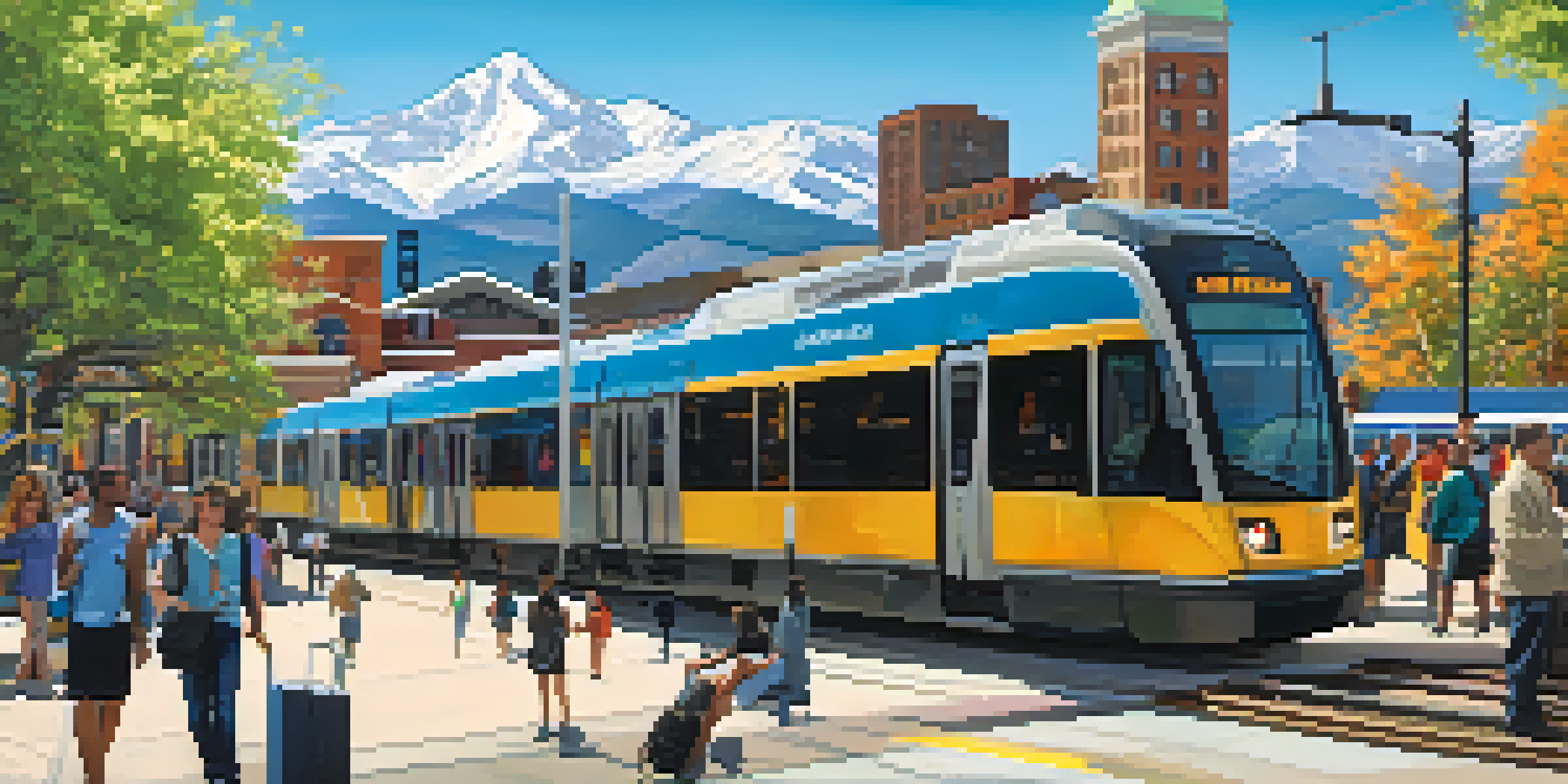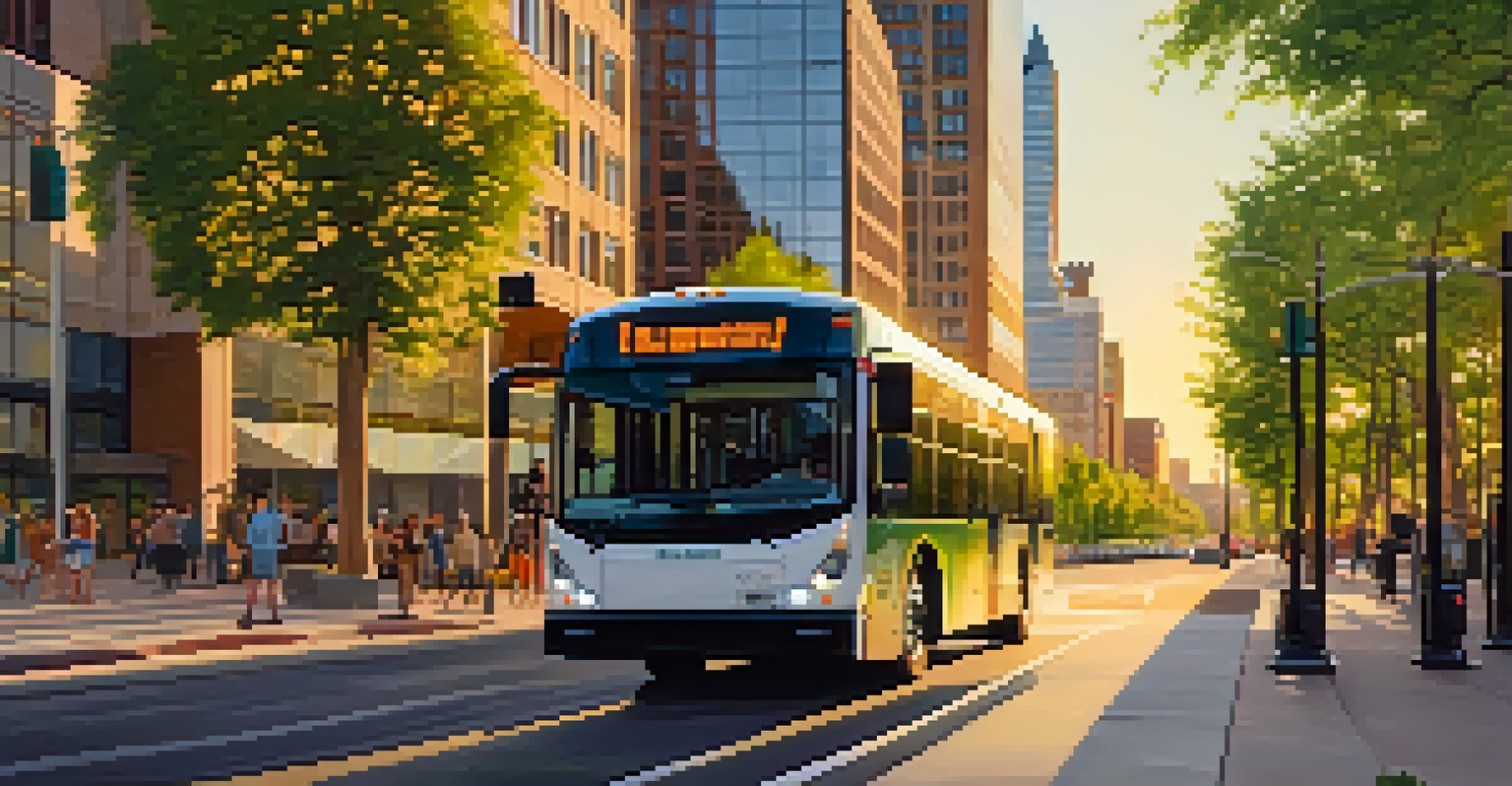The Role of Technology in Denver's Public Transportation Growth

The Evolution of Public Transportation in Denver
Denver's public transportation has come a long way since its early streetcar days. Initially, the system relied heavily on fixed routes and schedules, which often left commuters frustrated. However, technological advancements have paved the way for a more dynamic and user-friendly experience.
Public transportation is a vital part of our communities, and we must continue to innovate and improve these systems to meet the needs of our residents.
Today, the Regional Transportation District (RTD) offers a range of options, including buses, light rail, and commuter trains. These are not just modes of transport; they are increasingly integrated with technology to improve efficiency and rider experience. The evolution reflects a growing acknowledgment of the importance of accessible public transport in urban planning.
As Denver continues to expand, the role of technology in public transport is more crucial than ever. From real-time tracking to mobile ticketing, the city's approach is transforming how residents and visitors navigate the Mile High City.
Smart Technology Enhancements in Transit Systems
One of the most exciting developments in Denver's public transport is the integration of smart technology. This includes GPS tracking, which allows passengers to see when their bus or train will arrive in real-time. Imagine waiting at the bus stop without the uncertainty of wondering when the next ride will come—this is now a reality.

Furthermore, the use of mobile apps has made it easier to plan trips and purchase tickets. Riders can access information about routes, schedules, and even delays right from their smartphones. This convenience encourages more people to choose public transport over driving, which is a win for both transit agencies and the environment.
Tech Transforms Denver Transit
The integration of smart technology, like GPS tracking and mobile apps, enhances the efficiency and user experience of public transportation in Denver.
These smart technology enhancements not only streamline the commuting process but also enhance safety and reliability. With better information and resources at their fingertips, passengers feel more empowered to navigate the system confidently.
The Role of Data in Transportation Planning
Data is the backbone of modern transportation planning, and Denver is no exception. By analyzing ridership patterns, city planners can make informed decisions about where to expand services or which routes need improvement. This data-driven approach ensures that public transport meets the evolving needs of the community.
Sustainability is not a choice, but a necessity. The future of our cities depends on how we plan our transportation systems today.
For instance, if a certain bus route is consistently overcrowded, planners can increase the frequency of service. Conversely, routes with lower ridership can be adjusted to allocate resources more effectively. This strategic use of data not only enhances the efficiency of the system but also improves overall rider satisfaction.
Moreover, the collection and analysis of data help in addressing accessibility issues. By understanding the demographics of ridership, the city can ensure that all communities are served equitably, making public transportation a viable option for everyone.
Sustainability and Eco-Friendly Initiatives
As concerns about climate change grow, Denver's public transportation system is stepping up with eco-friendly initiatives. The city is investing in electric buses and energy-efficient trains, reducing its carbon footprint while providing reliable service. This commitment to sustainability resonates with environmentally conscious commuters.
In addition to cleaner vehicles, the integration of smart technologies also contributes to more sustainable practices. For instance, optimizing routes and schedules based on real-time data minimizes fuel consumption and reduces emissions. This multifaceted approach not only meets the needs of today but also protects the environment for future generations.
Data Drives Transportation Planning
By analyzing ridership data, Denver can make informed decisions about service expansions and improvements, ensuring public transport meets community needs.
Furthermore, these initiatives align with Denver's broader goals of becoming a more sustainable city. By promoting public transit as a green alternative to driving, the city is not just improving its transportation infrastructure; it's also fostering a culture of environmental responsibility among its residents.
Community Engagement and Feedback Mechanisms
Community engagement is essential for the success of any public transportation system, and Denver actively seeks feedback from its riders. Through surveys, public meetings, and social media, the city encourages residents to share their experiences and suggestions. This open dialogue helps transit authorities understand the needs and preferences of the community.
Moreover, involving the community fosters a sense of ownership among residents. When people feel their voices are heard, they are more likely to use the services and advocate for improvements. This collaborative approach not only enhances service quality but also builds trust between transit agencies and the public.
By prioritizing community feedback, Denver is ensuring that its public transportation system evolves alongside its residents. This responsive approach contributes to a more user-centered transit experience, making it easier for everyone to navigate the city.
The Future of Public Transportation in Denver
As technology continues to advance, the future of public transportation in Denver looks promising. Plans are already underway for further innovations, such as autonomous transit vehicles and enhanced connectivity between different modes of transport. These developments hold the potential to completely reshape how residents travel within the city.
Imagine a future where you can seamlessly transfer from a bus to a light rail, or even to an autonomous shuttle, all with minimal wait times. This vision of interconnected transit will not only improve convenience but also encourage more residents to opt for public transport over personal vehicles.
Sustainability in Transit Initiatives
Denver is investing in eco-friendly technologies, such as electric buses, to reduce its carbon footprint and promote sustainable commuting options.
The ongoing commitment to integrating technology in public transport reflects Denver's ambition to become a leading example of modern urban mobility. By embracing these changes, the city is paving the way for a more efficient, sustainable, and accessible transportation system.
Challenges and Solutions in Implementing Technology
While the integration of technology in Denver's public transportation system brings numerous benefits, it also presents challenges. Issues such as funding, infrastructure upgrades, and data privacy concerns can hinder progress. Addressing these challenges requires strategic planning and collaboration among various stakeholders.
For example, securing funding for new technologies often involves navigating complex governmental processes. However, public-private partnerships can provide innovative solutions and resources. By bringing together expertise and funding from both sectors, Denver can accelerate the implementation of new technologies in its transit system.

Additionally, ensuring data privacy is crucial as the city collects and analyzes rider data. Transparent policies and robust security measures can help build trust among commuters while still allowing for the benefits of data-driven planning. By tackling these challenges head-on, Denver can continue to advance its public transportation system effectively.